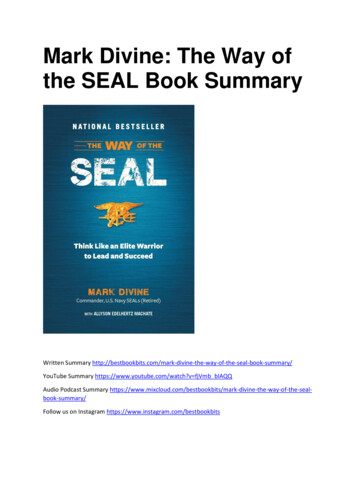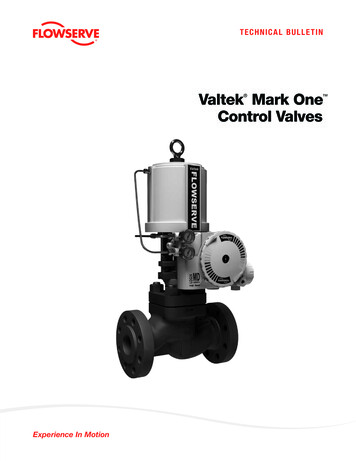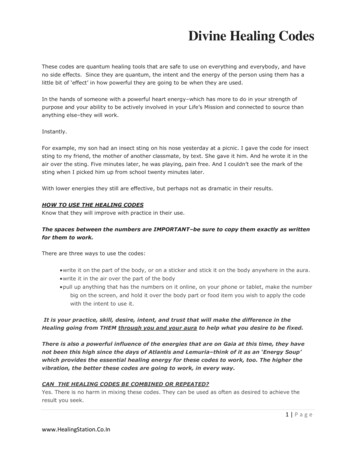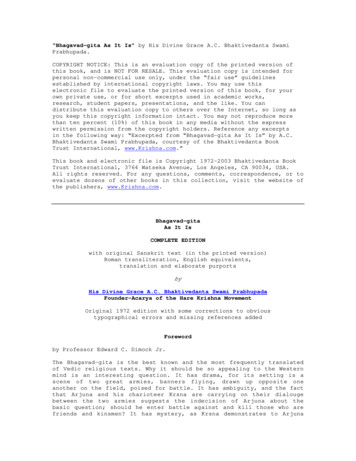
Transcription
Mark Divine: The Way ofthe SEAL Book SummaryWritten Summary -seal-book-summary/YouTube Summary https://www.youtube.com/watch?v fjVmb bIAQQAudio Podcast Summary the-way-of-the-sealbook-summary/Follow us on Instagram https://www.instagram.com/bestbookbits
LEAD FROM THE FIELDGenuine leadership must stem from the heart of an individual, regardless of (and sometimesin spite of) the organizational role or power systems in which he or she is enshrined.The world needs leaders who will lead from the front and push from the rear; who will standup and step out, risking more to enforce integrity at all levels—self, team, and organization.We also need organizations to embrace this concept and support the development ofindividuals and teams by allowing risk and failure in order to foster true learning—the kindthat develops the deep character that authentic leadership requires.PRINCIPLE 1: ESTABLISH YOUR SET POINTBy defining your stand and purpose, you will be able to use them as an internal GPS. Whenthe winds of pain and pleasure blow, you won’t change course.Make a StandLeading from the field requires that we first know ourselves, our true nature, inside and out.When we live in full awareness of our stand, then we can face fear with courage. Fear isnatural, something to be faced and understood, not to be avoided. Finding the courage toact in the presence of fear is the Way of the SEAL.Your stand should ultimately suggest those character traits you want to embody, even if youaren’t 100 percent there right now.
Find Your PurposeYour stand will answer the question “What would I do?” and your purpose will answer thequestion “Why am I here?”Clarify your values so you can become the kind of person who can stand his or her groundevery day. Values answer the question What do I want more of or less of in my life?PRINCIPLE 2: DEVELOP FRONT-SIGHT FOCUSIn SEAL-speak, your goals typically come in two types: You have your big, long-term goalsdefining your end state, and you have shorter-term subgoals defining your path along theway. SEALs work on one mission at a time, though there may be multiple targets to achieveoverall mission success. Whether you face immediate challenges or need a lasting long-termstrategy, you can overcome any obstacle and achieve any goal with front-sight focus througha four-pronged approach:1. Prepare Your MindBefore you can take control of your mind, you must first calm it down. The fastest way tocalm your mind, along with your body, is through slow and controlled deep breathing.By focusing on your breath, you collapse your focus to the “front sight” that is the presentmoment. This settling practice helps reduce mental chatter, prevents your mind fromwandering, and is generally a great boost to your self-control efforts.2. Envision Your Goal
Front-sight focus, especially when backed up by a powerful and clear set point, can propelyou toward each target on your way to mission success. But what exactly are you supposedto focus on? The key is to envision your goal—whether at the target or mission level—usinga type of visualization called “mental projection.The purpose of this type of visualization is to plant seeds of a future desired state, such asbecoming CEO of your company, into your subconscious mind and nervous system. As youtake action in the “real world,” the new inner vision will align your heart and mind with youractions and support your efforts to achieve that desired state.3. Define the MissionWhen you strive to achieve any goal (read: embark on a mission), you must clarify anddefine expectations, both explicit and implicit.Proper planning from the start will help prevent sudden and unfavorable consequences later,which could interfere with your ability to maintain front-sight focus on missions you’veaccepted or chosen.4. Simplify the BattlefieldSimplifying the battlefield” is SEAL-speak for eliminating distractions. When we eliminatedistractions, we can better see the simple, elegant solutions and remain front-sight focusedon the right way forward.First, you must know your unique offer as an individual, team, or business so you canidentify what you must do and what you can delegate to others. Then you must declutteryour internal and external environments so you can see simple solutions more easily.
When your clutter isn’t bogging you down, you literally and metaphorically have more roomfor the things you need.PRINCIPLE 3: BULLETPROOF YOUR MISSIONThere is a reason more than 95 percent of new business ventures fail within five years: Folksdon’t have the skills to eliminate uncertainty and mitigate risk.To avoid costly mistakes, you must bulletproof your mission, which means doing thefollowing 4 things;1. Select High-Value TargetsChoosing the right targets from the outset helps bulletproof your mission because you’llknow exactly where your resources are best directed.The FITS (Fit, Importance, Timing, Simplicity) process is designed it to determine whichtargets best fit the mission you’ve chosen, which in turn should connect to your purpose asdiscussed with Principle 1. FITS asks you to look at each possible target with regard to fourcriteria:– Does this target fit your skills and your team and does it give you a good return on yourinvestment?– How important is this target to achieving mission success?– Is the timing optimal for pursuing this target?– Is the target simple and clear?”It takes discipline to focus only on high-value targets instead of giving in to the temptation ofthe low-hanging fruit life serves up daily.
2. Explore Your OptionsThe right path forward is rarely crystal clear. Often we have multiple options for satisfying ourgoals, but they won’t rank equally as best for your situation. The key is to scope out youroptions so you can make the strongest decision for ensuring mission success.Once you’ve selected your high-value targets, you will use the PROP process to exploreyour options for achieving them and zero in on the right path forward. This tool asks:– To identify your current priorities?– What are the realities of the situation?– What options do your targets suggest?– Which path forward will you select?3. Communicate the MissionIf you can’t communicate your mission, you won’t get support, and worse, you may notrecognize disparities between your vision and your stakeholders’.You want people—whether they are potential partners, investors, or holders of other supportroles—to understand clearly what you want to do, why you’re doing it, what resources arerequired, and who’s in charge.The process of framing your mission as a story creates a visual mosaic of the mission plan,which is easy to digest for the team and others who need to be in the know, such aslogistical partners and higher-up decision makers.4. Dirt-Dive the Mission
Once you’ve clearly and visually defined your mission, you need to reconnect with itviscerally. Review it each morning individually and then review it together with your team inyour weekly meetings.Ideally, you will want to include both mental and physical components when you dirt-diveyour mission. However, sometimes a physical rehearsal may not make sense or be possible.At minimum, it’s always a good idea to dirt-dive through a mental rehearsal.When you and your team connect with a mission regularly, when you work out all the kinksand anticipate all the potential problems, your familiarization will enable you to face the realthing as if it were just another day.PRINCIPLE 4: DO TODAY WHAT OTHERS WON’TFind Your 20X Factor“You guys are capable of at least twenty times what you think you are.”Hard work builds character, while a soft life weakens it. Comfort imprisons us in a low-gradefear of suffering. We naturally shy from things that hurt, not understanding how much thispattern debilitates us and keeps us from experiencing life at its fullest. We must define ourcomfort zone, and then get the heck out of it! The 20X factor is all about embracing apersonal culture of mighty effort.Embrace the SuckSEAL trainers often say, “Pain is weakness leaving the body.” This encouraging metaphordescribes a fascinating alchemy: the transmutation of training-induced pain into confidencewhen performing, whether on the battlefield, playing field, or in life.
The first step to embracing the suck is to step up and face your fear of suffering. Pain is yourbody’s way of telling you that security is threatened because something is out of whack.However, when you consistently experience the personal growth that accrues fromdeliberately putting yourself out of balance, such as with hard workouts, you begin toembrace that temporary pain for the rewards it brings.One simple technique for embracing the suck of any painful situation is to change your stateby immediately focusing on something else that is positive . . . and then smiling or evenlaughing.Build the Three Ds (Discipline, Drive, and Determination)Our habits define us: Solid character habits define a solid character. Start putting your mindto developing the character habits of discipline, drive, and determination. Discipline is the spark that ignites the fire of a habit. Those fires must be lit daily, anddiscipline provides the original source energy. Discipline isn’t built or acquiredovernight. It starts with baby steps. Drive is the motivation behind your actions. How do we build drive? First, connect amajor life interest to your purpose and define a mission around it. Determination is the long-view commitment to the mission. When everyone else isdone for the day, the determined stay for an extra hour honing a skill, working on theirgear, or studying something new.PRINCIPLE 5: FORGE MENTAL TOUGHNESSMaking excellence a habit will take you a long way down the road toward every mission youfocus on and enable you to satisfy your purpose, leading to a happier, more fulfilling, andmeaningful life. But how exactly do you continue to hang on after others have let go?
Control Your ResponseYour immediate and unconscious reaction to surviving such a moment, whether literally orfiguratively, is likely to take a deep “phew” breath, followed by several more. Deep breathingis the universal shutoff switch to stress, but it’s also useful proactively to maintain your focus,as we learned with Principle 2.Control Your AttentionAttention control is the SEAL version of positive self-talk. At the simplest level, it means toshift our attention from the negative by talking to ourselves positively.It’s well known that whatever we focus on tends to become our reality, even if the focus is onnot wanting something. Negative input can plant seeds of destruction in our subconsciousmind, which then partners with our conscious mind in a conspiracy for failure.The art of positive self-talk is simply paying attention to your inner dialogue and directing ittoward positive, performance-based language.Develop Emotional ResilienceEmotional resilience is instrumental to your ability to forge mental toughness—it’s the powerto bounce back quickly when circumstances conspire against you.One must speak, visualize, and feel positively in order to be aligned in positivity. Otherwise,the emotional states counteract the positive self-talk and imagery, leading to weak results.The starting point is emotional awareness: Are you emotionally positive or negative?
Set Effective GoalsEach time you set a goal—whether it is big or long-term —you ignite a spiral of success thatfeeds your mental toughness. You’re giving yourself something to strive for (a “why”),something to visualize and focus on for positive momentum. And each time you achieve yourgoal, the thrill of success and the surge of confidence you receive expand your sense of self,enhance your emotional resilience, and make it that much easier to tackle the next mission.But you’re much more likely to achieve your goals if they are set properly in the first place.Well-stated goals are precise, positive, and written down. They are also measurable andhave an associated, and appropriate, timeframe. Your goals must be achievable in that youhave the potential to accomplish them with the skills and resources available to you. Whichleads to the last element of proper goal setting: Your goals must be realistic for you and yourlife situation. These attributes form the acronym SMART—Specific, Measurable, Achievable,Realistic, and Timely or Time-Bound.PRINCIPLE 6: BREAK THINGSApply Total CommitmentFor elite operators, commitment doesn’t mean you already know how you’re going to get itdone. “Find a way or make a way” was our motto in the SEALs. It means you will commitand then figure it out. Since no challenge is completely new or unique, to break the mold ofcurrent thinking, you’ll want to meld ideas from the past with informed predictions about thefuture to come up with new solutions for the present.Fail Forward Fast
Moving forward despite chaotic conditions—and sometimes because of them—is inherentlyrisky, and since we don’t shy from risk in the Way of the SEAL, you will inevitably experiencefailure, probably more often than you succeed, actually.The good news is that, failure is not as shameful as it once might have been—it’s becomealmost commonplace for an individual to lose his job or to see her business go belly-up. Intoday’s fast-paced world, new technologies change industries overnight.With the business, social, and political landscapes shifting like quicksand, “failing forwardfast” is more important now than ever. When you deliberately break something, you mustshift your perspective so that you both expect and welcome failure—you will seek it outbecause that is where the opportunities for personal and professional growth lie hidden. Infact, you’re getting it out of the way, knowing that only failure will bring the insights andlessons necessary to remake things better.Failing forward fast allows everyone to learn and gain momentum together in a rapidprocess. Failure is simply a step in a learning process that looks like this:1. Try something new.2. Fail.3. Analyze (a) the lessons we learned, and (b) how we can modify our approach to gainmomentum and prevent the failure again.4. Implement changes for the next iteration.5. Incorporate the insights personally and at the team level to shift your thinking foranother go-round, and perhaps adjust the system or process itself to reflect the newknowledge.6. Try it again and repeat steps 2 through 5 until you’ve succeeded in your mission.Navigate Gaps for Opportunity
Life will bring you plenty of opportunity in the form of failure and, as you embrace theconcept of failing forward fast with intention, you will accelerate toward opportunities forlearning and growth. But as a WOS leader, you can and should also proactively seek outopportunities for breaking things so you can remake them better.The speed of technological advancement has accelerated change in all areas of commerce,government, and our personal lives. As these new realities depart from the old boundarylines, gaps open, and in these gaps arise numerous opportunities. During transition periodssuch as we are currently experiencing, there will be more chaos, more reality gaps, andmore opportunities. These opportunities are yours to grab.Innovate and Adapt QuicklyAfter risk aversion and fear of failure, indecision is perhaps the most common reason for thatinnovation-killing standstill we call inertia. The thing is, any plan is better than no plan, and agood plan executed now is far better than a perfect plan executed too late.You need to get comfortable with a “good enough” plan and develop conviction in the beliefthat your decisions will improve as you fail forward fast and tap into your resources.You can’t allow a fear of failure to keep you from ever starting! Let your intuition guide you.Your perspective will shift as you act, which is a good thing, and you’ll tighten things up asyou go. So, after taking a moment to assess the situation, make a decision, use the toolsand take action as soon as possible.PRINCIPLE 7: BUILD YOUR INTUITION
Most of your creativity and some of your best ideas will come from the hidden inner mind ofyour subconscious. Once you learn to harness this powerful intelligence, you will breakthrough to new levels of awareness and accomplishments.Expand Your AwarenessAwareness is the ability to pay close attention to the whole and the parts of a situationsimultaneously. We want to be able to take it all in while also maintaining an attention todetail.Intuition development requires us to expand our range of awareness and tap into oursubconscious minds at will. The art of using your intuition is to learn by absorbing moreinformation and then accessing it in a sensible form. This skill can help us make betterdecisions and avoid danger or problems, especially on the fly or in chaotic situations.Your awareness does expand naturally as you age, travel, and take in more experiences.However, you can still be closed to the deeper wisdom within you if you remain in your headall the time. Expand your awareness deliberately by getting out of your head and deepeningyour connection to your senses and your subconscious genius.Strengthen Your Sensory PerceptionSlowing down and engaging the senses fosters a sense of mindfulness. Mindfulness is apractice that leads to a deeper connection with your inner self, a more present state ofawareness through which your wisdom can flow. To facilitate this, you want to develop yoursensory perception, which means that you take in more information through each of yoursenses.Develop your sensory perception by tuning into and turning on your senses.
Uncover Your Background of ObviousnessLife experiences, especially those from early childhood, can remain with us a long time. Westore what we need to actively remember in order to survive and thrive—in our memorycenters. The bulk of the details are imprinted at a deep, subconscious level. They oftensolidify into negative or destructive beliefs, which then drive our behavior in subtle ways foryears after the experience itself. Your Background of Obviousness (BOO). That’s becausethey are hidden in plain sight, obvious to others but not to you.If you want to succeed at the highest levels, you must align the inner with the outer. Thistheme repeats itself in this book because it is a base requirement for many of the techniquesto work at maximum effectiveness. Often this means you will have to reconnect with or reliveyour hidden experiences.Recap your past and tune in with how you developed the beliefs and behaviors you havenow, many of which may be holding you back or interfering with your ability to make gooddecisions.Open Up to Your Inner WisdomThe next stage of this process is to open up a channel for your subconscious mind tocommunicate with you more clearly. Providing more detailed information than a simplefeeling in your gut, and a tool for clearing out any baggage that clouds your present decisionmaking.PRINCIPLE 8: THINK OFFENSE, ALL THE TIME
Whether at home, at work, or even out having fun, how you think and deal with opportunitiesand threats will determine whether you are the victor or victim. Destiny can strike anytime,anywhere. For success in the Way of the SEAL, you must develop your winning attitude andbecome a more offense-oriented leader.Develop Unwavering ConfidenceMake an honest assessment of the language that you use on a daily basis. Do you usenegative or “slow down” words? Practice using new language daily and journal your findingsevery week. Keep at this until it becomes a new habit and second nature.Activate Your RadarLike a SEAL, you must learn to act aggressively and rapidly when you become aware of thethreats facing you. You must also take advantage of opportunities by innovating andadapting, doing the unexpected to keep your competition off balance.Do the UnexpectedDoing the unexpected fundamentally asks you to look at things from a different angle thaneveryone else. When you train yourself to see what others don’t see, then you can unlockyour innate creativity. People generally expect that others will follow “the rules,” which mayliterally be rules as in a competition or may be somewhat more abstract as in cultural norms.So, it naturally follows that doing the unexpected often means breaking the rules.Execute with Velocity and Agility
In business, speed—or velocity—keeps you ahead of the competition and keeps them offbalance, surprising them at every turn. Apple gets kudos for their creativity, but Samsunggets the award for speed—they stunned the iPad creator with how quickly they produced acompeting tablet.You are well aware that the pace of change is accelerating as technology pushes thereaches of globalization. Remain static and you lose momentum, visibility, and opportunities.Eventually you become stuck in a cryogenic deep freeze as the world blazes by. Like theSEALs, WOS leaders set the conditions for rapid execution by: trusting those in the field applying standard operating procedures utilizing a shoot, move, and communicate processPaulminors.com
mind, which then partners with our conscious mind in a conspiracy for failure. The art of positive self-talk is simply paying attention to your inner dialogue and directing it toward positive, performance-based language. Develop Emotional Resilience Emotional resilience is instrumental











